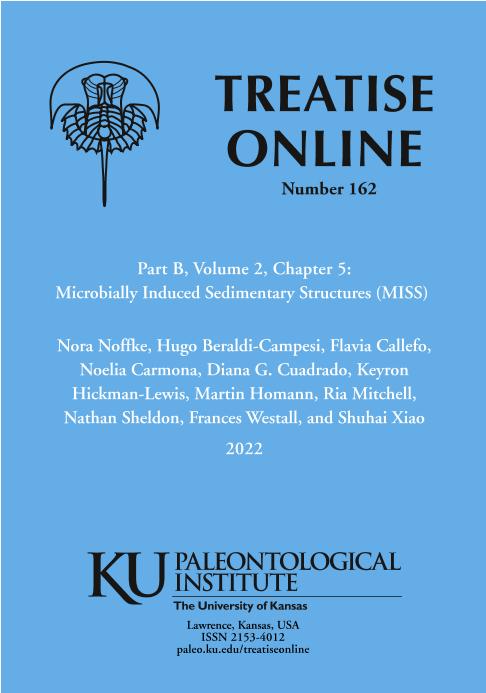Artículo
Microbially induced sedimentary structures (MISS)
Noffke, Nora; Beraldi Campesi, Hugo; Callefo, Flavia; Carmona, Noelia Beatriz ; Cuadrado, Diana Graciela
; Cuadrado, Diana Graciela ; Hickman Lewis, Keyron; Homann, Martin; Mitchell, Ria; Sheldon, Nathan; Westall, Francis; Xiao, Shuhai
; Hickman Lewis, Keyron; Homann, Martin; Mitchell, Ria; Sheldon, Nathan; Westall, Francis; Xiao, Shuhai
 ; Cuadrado, Diana Graciela
; Cuadrado, Diana Graciela ; Hickman Lewis, Keyron; Homann, Martin; Mitchell, Ria; Sheldon, Nathan; Westall, Francis; Xiao, Shuhai
; Hickman Lewis, Keyron; Homann, Martin; Mitchell, Ria; Sheldon, Nathan; Westall, Francis; Xiao, Shuhai
Fecha de publicación:
06/2022
Editorial:
University of Kansas
Revista:
Treatise on Invertebrate Paleontology
ISSN:
2153-4012
Idioma:
Inglés
Tipo de recurso:
Artículo publicado
Clasificación temática:
Resumen
To date, microbialites include five groups: stromatolites, thrombolites, leiolites, and dendrolites. All these microbialites occur in carbonate or silica lithologies. However, research during the past 25 years has defined an additional group of microbialites that occurs predominantly in clastic deposits. These structures are called microbially induced sedimentary structures, commonly simply abbreviated to MISS. As outlined in this chapter, the morphologies of MISS do not resemble those of precipitated microbial- ites due to the much different formation and different location of these structural groups. The genesis of the main types of MISS has been elucidated in studies in modern environments. The results were key for the search of such structures in the fossil record. Systematic exploration from youngest to oldest stratigraphic successions has given rise to a data set that allows identification of MISS in respective paleoenvironments. MISS are biosignatures helpful to under- standing aspects of prokaryote evolution and the search for life on other planets. This chapter first briefly focuses on the microbial communities that cause the struc tures, then discusses MISS formation, which is intimately related to the immediate setting. Next, the processes of their preservation is examined, and, finally, the chapter arrives at the classification of MISS.
Palabras clave:
BIOFILM
,
MICROBIAL MATS
,
BIOSTABILIZATION
,
PRESERVATION
Archivos asociados
Licencia
Identificadores
Colecciones
Articulos(IADO)
Articulos de INST.ARG.DE OCEANOGRAFIA (I)
Articulos de INST.ARG.DE OCEANOGRAFIA (I)
Articulos(IIPG)
Articulos de INSTITUTO DE INVESTIGACION EN PALEOBIOLOGIA Y GEOLOGIA
Articulos de INSTITUTO DE INVESTIGACION EN PALEOBIOLOGIA Y GEOLOGIA
Citación
Noffke, Nora; Beraldi Campesi, Hugo; Callefo, Flavia; Carmona, Noelia Beatriz; Cuadrado, Diana Graciela; et al.; Microbially induced sedimentary structures (MISS); University of Kansas; Treatise on Invertebrate Paleontology; 162; 6-2022; 1-29
Compartir



